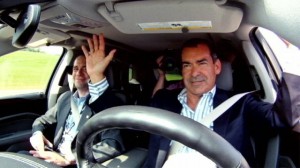By 2020, General Motors plans to have a car on the road that can nearly pilot itself. Calling the system a “Super Cruise,” the vehicle will use radar and cameras to steer the car and keep it inside the lanes. The radar will be used to keep the vehicle from tailgating, braking to come to a stop should it have to.
GM, as well as several other major automotive manufactures already produce vehicles that use radar to help with the cruise control, preventing tailgating. Some of those models will even stop the car completely. The ability to steer the vehicle though, is a new feature.
New Technology and Risks

The company will be testing the new technology in Milford, Michigan. There are still a number of bugs that need to be worked out, but the recent test for reporters of the Cadillac SRX SUV was still impressive.
Engineers acknowledge they are still a long way from road conditions. Adjustments must still be made to the reaction of sensors, how the computer will react without lane lines, and how the computer would interact if the driver tried to override its actions.
One risk though, is that drivers may become complacent. GM will have to devise a system that keeps the driver engaged and paying attention. Other obstacles include how to program the computer to react to other drivers not using the technology. A computer will act in a predictable fashion, people do not. For these reason, GM engineers believe a true driverless car is still 20 to 30 years away.
It is not hard to imagine that should an accident occur, a car accident lawyer would attempt to seek compensation for his or her client from GM, adding to the risk of rushing this new technology. In order to mitigate this risk, GM is not claiming this to be a driverless car. GM is stating that this vehicle will “assist” the driver who is still ultimately in control of the vehicle.
Announcements from the Competition
The same day that GM arranged their demonstration for reporters, Honda announced it was working on a communications tool that would use a pedestrians smartphone to warn both the pedestrian and driver of a possible accident. The vehicle would use software that is aware of the presence of the phone in the its path.
Another project of Honda’s is a system to warn drivers of cars and trucks about motorcycles in the vehicle’s blind spots. Both of these Honda technologies are still in the early experimental stages with many obstacles that still need to be tackled.
Nissan has also made a announcement regarding this technology. They stated they want to make cars that drive themselves by 2020. They have developmental facilities working with several universities and a testing ground near the company headquarters in Japan.
It seems that by 2020, several car companies will be competing using the “Super Cruise” style of technology. It remains to be seen though, if the manufacturers will be able to overcome the significant obstacles still in front of them.

